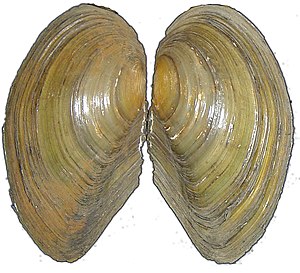Unionida
| Unionida | ||||||||||||
|---|---|---|---|---|---|---|---|---|---|---|---|---|

Common pond clam ( Anodonta anatina ) |
||||||||||||
| Systematics | ||||||||||||
|
||||||||||||
| Scientific name | ||||||||||||
| Unionida | ||||||||||||
| Stoliczka , 1871 |
The Unionida , also called freshwater mussels or naiads , are an order of mussels . They belong to the superorder Palaeoheterodonta . The first representatives are known from the Middle Devonian . The Unionida are probably the sister group of the Trigoniida . About 700 recent species are currently included in this group. In addition, there is a previously unknown number of fossil species.
Characteristic
The Unionida order essentially comprises the so-called "freshwater mussels". However, other groups of mussels have also penetrated into the freshwater, so that the reverse conclusion that all “freshwater mussels” belong to the Unionida is incorrect. The housings are usually single-sided. The shell consists of a thick layer of mother-of-pearl, a thinner prismatic layer overlaid by a thick layer of the organic periostracum. The castle is heterodont, schizodont or largely reduced. The ligament is usually external. Almost all forms have more or less distinct isomyar sphincters. The surface line is integripalliat.
Systematics
The classification of the order Unionida is not yet uniform. While some malacologists still advocate a division into one or two superfamilies (plus two exclusively fossil groups), others only list the families. The phylogeny within the Unionida order is currently still very much in flux.
- Superfamily Unionoidea Rafinesque, 1820
- Family river pearl mussels (Margaritiferidae) Haas, 1940
- Family river and pond mussels (Unionidae) Fleming, 1828
- Superfamily Etherioidea Deshayes, 1830
- Family Etheriidae Deshayes 1830
- Family Hyriidae Swainson, 1840
- Family Mycetopodidae Gray, 1840
- Family Iridinidae Swainson, 1840
- Superfamily † Archanodontoidea Weir, 1969
- Family † Archanodontidae Weir, 1969
- Superfamily † Anthracosioidea Amalitsky, 1892
- Family † Anthracosiidae Amalitsky, 1892
- Family † Palaeomutelidae Weir in Vokes, 1967
- Family † Prilukiellidae Starobogatov, 1970
- Family † Nyassidae Hall, 1885
- Family † Ferganconchidae Martinson, 1961
- Family † Pseudocardiidae Martinson, 1961
Phylogeny
The phylogeny of the recent Unionida groups was recently examined by Graf & Cummings (2006) who found the greatest likelihood of the following cladogram:
| Palaeoheterodonta |
|
||||||||||||||||||||||||||||||||||||
|
|
Unionoidea and Etherioidea likely form sister groups. Within the Unionoidea, in turn, Unionidae and Margaritiferidae form sister groups. Within the Etherioidea, Hyriidae and an as yet unnamed taxon consisting of Etheriidae (freshwater oysters), Mycetopodidae and Iridinidae face each other.
literature
- Michael Amler, Rudolf Fischer & Nicole Rogalla: mussels (Haeckel library, volume 5). Enke Verlag, Stuttgart 2000, ISBN 3-13-118391-8 .
- Rüdiger Bieler & Paula M. Mikkelsen: Bivalvia. A look at the branches . In: Zoological Journal of the Linnean Society , Vol. 148 (2006), pp. 223-235, ISSN 0024-4082
- Daniel L. Graf & Kevin S. Cummings: Palaeoheterodont diversity (Mollusca: Trigonioida + Unionoida). What we know and what we wish we knew about freshwater mussel evolution . In: Zoological Journal of the Linnean Society , Vol. 148 (2006), pp. 343-394, ISSN 0024-4082